BISAC NAT010000 Ecology
BISAC NAT045050 Ecosystems & Habitats / Coastal Regions & Shorelines
BISAC NAT025000 Ecosystems & Habitats / Oceans & Seas
BISAC NAT045030 Ecosystems & Habitats / Polar Regions
BISAC SCI081000 Earth Sciences / Hydrology
BISAC SCI092000 Global Warming & Climate Change
BISAC SCI020000 Life Sciences / Ecology
BISAC SCI039000 Life Sciences / Marine Biology
BISAC SOC053000 Regional Studies
BISAC TEC060000 Marine & Naval
Winter climatic anomalies of various time scales in the Japan, Okhotsk seas and Baikal Lake Basin are revealed and compared with anomalies in the Pacific, Indian and Arctic oceans. Time series of ice extent in the Japan and Okhotsk seas, ice thickness and seasonal duration of the ice cover in the Baykal Lake, as well as Hadley SST, surface heat fluxes, wind velocity, atmospheric pressure fields (SLP) and different climatic indices are analyzed. The decadal climate anomalies in the Japan and Okhotsk seas in mid winter, as compared to the Northeast Pacific and South Siberia regions, could have a reversed phase. Alternating cold/warm decadal anomalies in different longitude zones of the North Asian Pacific are accompanied by alternating meridional wind and SLP anomalies at temperate latitudes. Alternating zones of inversed anomalies in temperate latitudes of the Asian Pacific are related to teleconnections with anomalies in both Arctic and Indo-Pacific oceans. Negative SSTA in eastern/central tropical-equatorial Pacific and positive SSTA in El Nino area accompanies rise of northern wind and ice extent in the Okhotsk/Japan Seas in mid-winter. The best predictors of the high cold anomaly in February in the western subarctic Pacific and marginal seas are reduction of the SST and net heat flux from the atmosphere to the ocean in north-eastern and central North Pacific during warm period of a previous year. At the multidecadal time scale the warming/cooling in the Northeast Pacific accompany winter warming/cooling in the Baykal Lake area during all period of observation. At interdecadal time scales the significant link of winter climate oscillations in South Siberia (Baikal Lake Basin) is found with SSTA oscillations in the equatorial region of the Indian Ocean and certain areas of the Pacific Ocean. The linkages of anomalies in the Baikal Lake Basin, Okhotsk, Japan Seas with regional anomalies in some key areas of the Pacific and Indian Oceans, related to the atmospheric centers of action are more stable than that with climatic indices. After climate regime shift in late 70s warm decadal anomaly in both Lake Baykal Basin and Indian Ocean in boreal winter accompany high positive anomaly of the Arctic Oscillation. Scenarios of extreme anomalies in the Baikal Lake Basin and Subarctic Pacific marginal area are also presented.
climatic anomalies, Pacific, Indian, Arctic, ocean, Lake Baikal, ice thickness, Japan, Okhotsk, sea, ice extent, surface heat fluxes, wind velocity, surface pressure, teleconnections.
I. Introduction
The ENSO-scale, decadal, interdecadal and multidecadal (50-70 years) climate oscillations are presented in numerous studies based on the data analyses of the observational records in the Pacific, Arctic, Atlantic oceans and land areas [1-6] including Russian Far East and south Siberia [7]. The interannual, decadal and interdecadal oscillations vary in space and time in the ocean-atmosphere system. The multidecadal oscillation is approximately in phase in the Pacific [4], Arctic [5] and Atlantic Oceans [6] and looks like global scale phenomena [3]. Transition period between positive and negative phases of the multidecadal oscillation can be 5-8 years that is very rapid in comparison with the oscillation period. The well known transition period named as climate regime shift in late 70s of the 20th century was revealed both in the North Pacific [8] and North Atlantic [9] ocean-atmosphere system. Recent shifts in the state of the North Pacific from 1999 to 2012 in terms of phase trajectory of the first two principal component of SST anomalies in the North Pacific is revealed in [10]. The climatic regime changes in the Pacific, Indian Oceans and Asia both in late 70s and late 90s in terms of phase trajectory of Sea Level Pressure (SLP) and surface net heat flux (Q) is shown in [11]. A lot of extreme events in the atmosphere and ocean were observed in the first 15 years of the 21 century including extremes in 2014, 2015. In Russia the extremely low level of the Lake Baikal (South Siberia) is observed in fall 2015. At the same time an inverse extreme anomaly is observed in the Lake Khanka situated in the south of Russian Far-East (Primorskii Krai). The high level and flood of the Lake Khanka have reached a maximum in the fall of 2015 that has led to flooding of coastal houses and agricultural grounds.
The main goal of our study is to reveal and compare regional climatic and anomalies of various time scales in areas of temperate latitude band of the Asian Pacific Region, including South Siberia, Lake Baikal Basin, Russian Far East, Okhotsk and Japan Seas. The study is based on statistical analyses of the observation records. It is focused on features and relationships between multiple scale winter climatic anomalies in the Okhotsk, Japan (East) Seas, Lake Baikal Basin and similar scale anomalies different latitude zones of the Pacific and Indian Oceans.
II. Data and methods
We use observation data included gridded monthly mean time series of Hadley (GB) Sea Surface Temperature (SST) from 1870 to 2015, NCER NCAR meteorological reanalyses (1948-2015) pressure atmospheric pressure (SLP), air temperature (SAT), surface net heat flux, as well as monthly mean time series of Ice Extent [12, 13] in the Okhotsk Sea and Japan Sea (Tatarskii Strait) from 1948 to 2013, Baykal Lake Ice Thickness (1946-2013) and duration of the seasonal Ice Cover (in days) in the Baikal Lake from 1900 to 2012, Arctic Oscillation (AO), Pacific Decadal Oscillation (PDO), Multidecadal Atlantic Oscillation (AMO) indices.
Lagged and unlagged relationships between time series at different time scales are estimated by using standard filtering method and correlation analyses.
III. Winter anomalies of various time scales and their linkages
The climatic oscillations with periods 3-8 years and 18-21 years prevail in the Okhotsk and Japan Sea Ice Extent. High positive anomalies of the Ice Extent in February both in the Japan and Okhotsk Seas were observed in 1961, 1979, 2001 years. In the Okhotsk Sea it was also in 1967. Low anomalies was observed in 1963, 1984, 1991, 1994, 2007, 2009, 2011 in the Okhotsk Sea, and in 1949, 1957, 1974, 1991, 1994, 2011 in the Japan Seas (Fig.1,2).
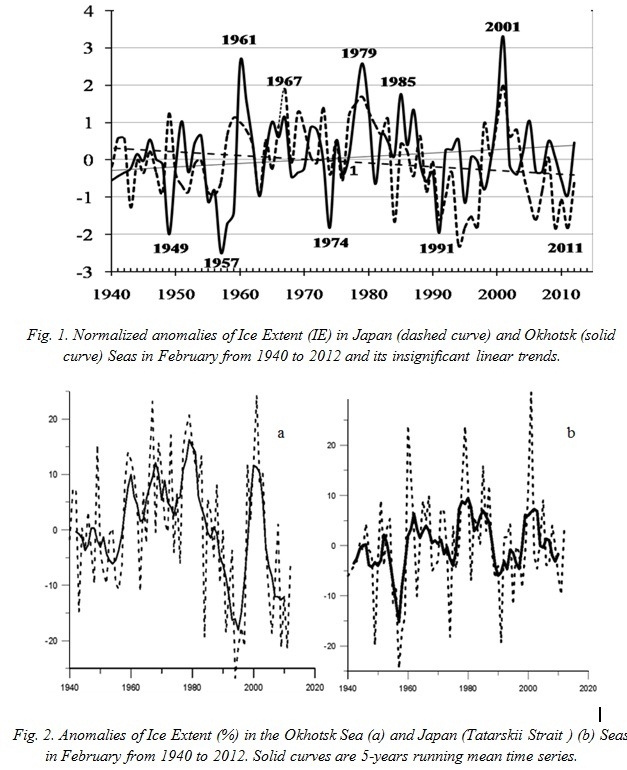
The rise/decrease of the Ice Extend in the Okhotsk, Japan/East Seas is accompanied by winter Sea Surface Temperature (SST) decrease/rise in central extratropic and subarctic North Pacific with maximal correlation coefficient (0.8) in western subarctic region adjacent to the Okhotsk Sea and Tatarskii Strait (Fig. 3d, Fig.4d). At the same time the Japan Sea Ice Extent positive/negative anomaly is accompanied by SST decrease/rise in central tropical Pacific (Fig. 3d) and rise/decrease in eastern southern tropic area, while the Okhotsk Sea Ice Extent in rise/decrease is accompanied by SST decrease/rise in western tropical and south subtropical Pacific (Fig. 4d, south of 30°S) as well as SST rise/decrease in eastern southern tropical area in the equatorial El Nino area (NINO3, NINO 3-4). Similar El Nino signal in the Okhotsk Sea and adjacent subarctic area was shown in [14, 15] in terms of both unlagged and lagged correlation between Southern Oscillation Indices/NINO3 and anomalies of Surface Air Temperature (SAT), SST, Ice Extent (IE) in winter.
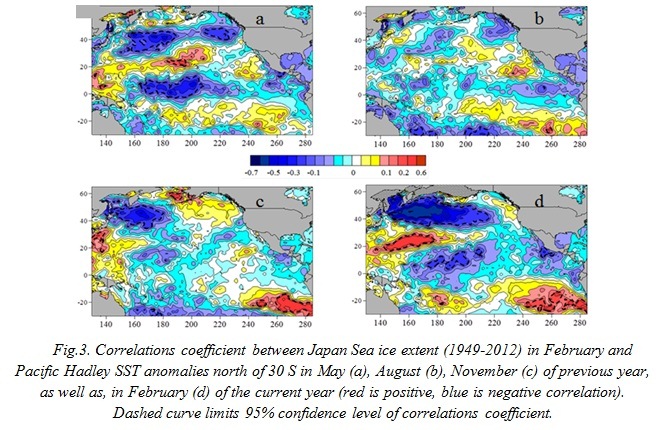
The cold winter anomalies in the Japan and Okhotsk seas are also associated with increased net heat flux (Q) from the ocean to the atmosphere in February (Fig.5) and during cold period of a year in the western tropical and subtropical zones in case of the Japan Sea, as well as in the western subtropical and subarctic zones of the North Pacific in case of the Okhotsk Sea. Typical meteorological situation in the cold winters is characterized by extremely strong North-East Asian winters monsoon, Siberian High and Aleutian Low resulted in rise of the Ice Extend in the Okhotsk and Japan Seas. The surface net heat flux directed to from the atmosphere to the ocean is weakened in the equatorial and tropical zones in this case. The best predictors of the high cold anomaly in February in the western subarctic Pacific and marginal seas are reduction of the SST and net heat flux from the atmosphere to the ocean in north-eastern and central North Pacific during warm period of a previous year (Fig. 3-5). In case of the Okhotsk Sea the negative anomaly of the SST in the western tropical Pacific in summer is also observed before cold winter. The anomalies of the Ice Extent in the Okhotsk, Japan Seas and net heat flux in the North Pacific in extremely cold February 2001 and warm February 2011 are associated with inversed phases of the decadal oscillation (Fig.5). In the extreme winters the anomalies of Q are much higher and occupy the western Pacific north to 30°S. It is accompanying the intensification of winter monsoon and weakening summer monsoon in the Russian Far East.
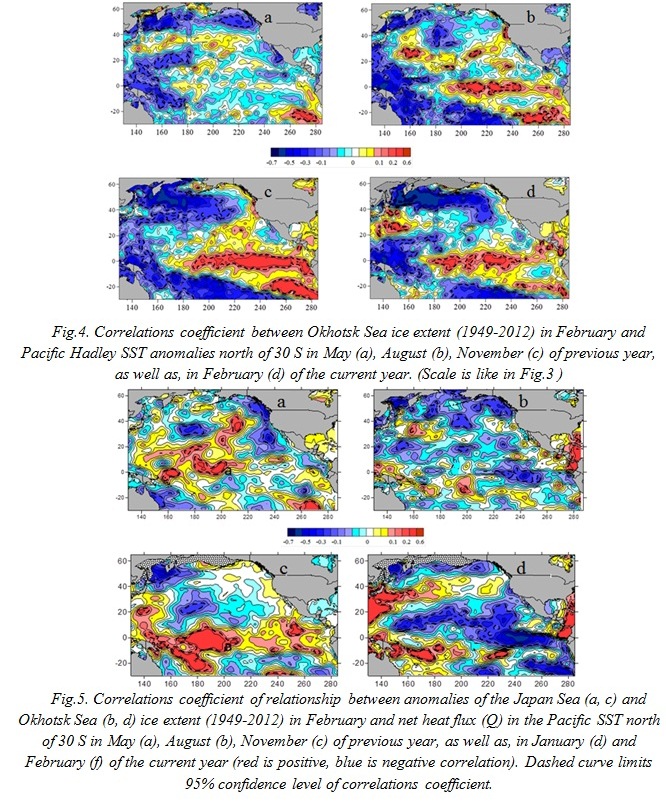
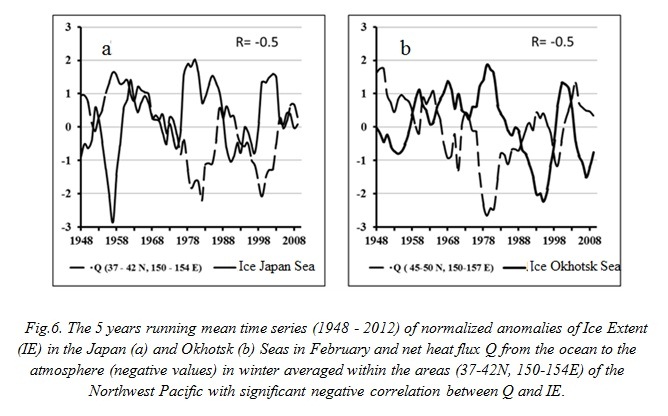
The relationship between Arctic Oscillation (AO) and Ice Extent in the Japan Sea (Fig.7a) is found on the interdecadal time scales with period about 25-28 years. The relationship between Arctic Oscillation (AO) and Ice Extent in the Japan Sea (Fig.7a) is found on the interdecadal time scales with period about 25-28 years. When the AO is in its positive phase and colder air circulates across the Arctic region, winter in subarctic Asian-Pacific region is warmer and the Ice Extent in the Japan Sea decreases. The relationship between Arctic Oscillation and Ice Extent (IE) in the Okhotsk Sea in February is changed from positive to negative (Fig.7b) after climate regime shift in the North Pacific in 70s of the 20th century. The multidecadal oscillation with period about 50 years is clear seen in the Ice Extent of the Okhotsk Sea.
The linkages of decadal climate variability in south Siberia (seasonal ice coverage duration in the Baykal Lake in winter with annual mean Arctic Oscillation Indices (AOI) and Sea Surface Temperature Anomaly (SSTA) in equatorial region of Indian Ocean in boreal winter on decadal time scale is shown in Fig.8. Similar high positive decadal SST anomaly in early 90s occurs in El Nino region, while it is negative in mid-latitude Indian and Pacific Oceans of Southern Hemisphere.

The normalized anomalies of 5-years running mean time series of the Ice Extent (solid curve) in the Japan (a), Okhotsk (b) Seas and Ice Thickness in the Baykal Lake (dashed curve in Figs. a,b) shown in Fig.9. The interdecadal oscillation of the Ice Extent in the marginal seas is usually in inversed phase in comparison with oscillation of the Ice Thickness in the Baykal Lake with exception of warming period in late 89-early 90s. The anomalies of each scale in the Baykal Lake including decadal scale are controlled by the anomalies of surface wind (Fig.10). Decrease of southern wind, increase of northern one over Lake Baikal result in rise of the ice thickness. The anomalies of the Ice Extent in the Japan and Okhotsk Seas are controlled by similar northwestern wind anomaly directed from the cold continent region to the Okhotsk Sea and northwestern area of the Japan Sea.

The multidecadal oscillation of both maximal seasonal Ice Thickness (IT) in the Baykal Lake (solid curve) and annual mean SST(dashed curve) in the Northeast Pacific (40-60N; 160-145 W) is shown in Fig.11 with annual mean Atlantic Multidecadal Indices (AMO, blue curve) in terms of normalized anomalies of 11 years running mean time series. At the multidecadal time scale the warming/cooling in the Northeast Pacific accompany winter warming/cooling in the Baykal Lake area during all period of observation. The AMO has same phase with SST and IT multidecadal oscillation only from 1950 to 1985 and later AMO has delayed phase.
The relationship between ice characteristics in the Lake Baikal, Okhotsk, Japan Seas Ice Extent and other climatic indices can be also changed after climate regime shift. The linkages of anomalies in South Siberia, Okhotsk, Japan Seas with regional anomalies in some key areas of the Pacific and Indian Oceans, related to the atmospheric centers of action are more stable than that with climatic indices. At the interdecadal time scale the oscillations of the Ice cover characteristics in the Baykal Lake are also in phase with SST anomalies in both equatorial Indian Ocean in boreal winter (Fig.8b) and North East Pacific. It seems to be that interdecadal (period is about 20-30 years) and multidecadal oscillations (50-60 years) in moderate latitudes of the Asian Pacific is substantially conditioned by anomalies of similar scales in both tropical-equatorial regions and Arctic Ocean. The high decadal anomaly in 90s in Arctic, Indo-Pacific, South Siberia, Japan and Okhotsk Seas is also associated with climate regime change in 70s.
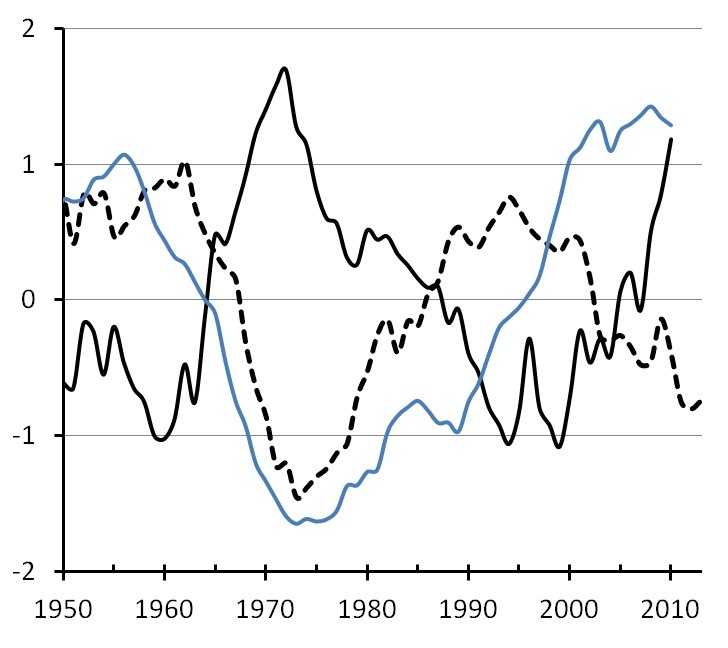
Fig.11. Normalized anomalies of 11 years running mean time series (1948 - 2012) of Ice Thickness in the Baykal Lake (solid curve) and annual mean SST anomalies(dashed curve) in the Northeast Pacific (40-60N; 160-145 W) and Multidecadal Atlantic Oscillation Indices ( blue curve).
IV. Conclusion
The inversed decadal, bidecadal oscillations are typical for different areas of the Asian Pacific, Indian and Pacific Oceans. The amplitude of the oscillations is increased in warm multidecadal climate regime after climate regime shift in 70s of the 20th century. The decadal, interdecadal and multidecadal climate oscillations in the Okhotsk and Japan Seas have basically stable relationship to the anomalies in the certain areas of the tropical and extratropical Pacific Ocean. The interdecadal climate oscillation in South Siberia is basically related to the similar scale oscillation in the Indian Ocean and North Eastern Pacific region adjacent to the Alaska Gulf. After climate regime shift in late 70s warm decadal anomaly in both South Siberia (Lake Baykal area) and Indian Ocean in boreal winter accompany high positive anomaly of the Arctic Oscillation. At decadal, interdecadal time scales there are significant global scale teleconnection, accompanying processes and links in the ocean-atmosphere system between tropical-equatorial Indo-Pacific Ocean, extratropic Asian Pacific Region and Arctic Ocean.
V. Acknowledgment
The study was supported by Russian Academy of Science Program Dalnii Vostok 15-I-1-047o and RFBR Grant 15-05-03805.
1. H. Nakamura, G. Lin, and T. Yamagata, “Decadal climate variability in the North Pacific during the recent decades,” Bull. Amer. Meteorol. Soc., vol. 78, № 10, 1997, pp. 2215-2225.
2. A.J. Miller and N. Schneider, “Interdecadal climate regime dynamics in the North Pacific Ocean: Theories, observations and ecosystem impacts,” Progr. Oceanogr., vol. 47, 2000, pp. 355-379.
3. M.E. Schlesinger and N. Ramankutty, “An oscillation in the global climate system of period 65-70 years,” Nature, vol. 367, February 1994, pp. 723-726.
4. S. Minobe, “A 50-70 year climatic oscillation over the North Pacific and North America,” Geophys. Res. Lett., vol. 24, 1997, pp. 683-686.
5. I.E. Frolov, Z.M. Gudkovich, V.P. Karklin, E.G. Kovalev, and V.M. Smolyanitsky, Climate Change in Eurasian Arctic Shelf Seas: Centennial Ice Cover Observations, Springer Praxis Books Geophys. Sciences, Chichester, UK, p. 164, 2009.
6. P. Chylek, Ch. K. Folland, G. Lesins, M. K. Dubey, and M. Wang, “Arctic air temperature change amplification and the Atlantic Multidecadal Oscillation,” Geoph. Res. Lett., vol. 36, L14801, July 2009.
7. V.I. Ponomarev, V.V. Krokhin, D.D. Kaplunenko, and A.S. Salomatin, “Multiscale climate variability in the Asian Pacific,” Pacific Oceanography, vol. 1. № 2, 2003, pp. 125-137.
8. L. Wu, D. Lee and Zh. Liu, “The 1976/77 North Pacific Climate Regime Shift: The Role of Subtropical Ocean Adjustment and Coupled Ocean-Atmosphere Feedbacks,” J. Climate, vol.1, 2005, pp. 5125-5240.
9. V.I. Byshev, V.G. Neiman, Yu.A. Romanov, and I. Serykh, “Phase variability of some characteristics of the present-day climate in the Northern Atlantic region,” Doklady Earth Sciences, vol. 438, 2011, pp. 887-892
10. N. Bond, J. Overland, M. Spillane, and P. Stabeno, “Recent shifts in the state of the North Pacific,” GRL, vol. 30(23), 2003, pp. 2183-2186.
11. V.I. Ponomarev, E.V. Dmitrieva, and S.P. Shkorba, “Featuries of climatic regimes in the North Asia Pacific,” Russian Systems of environment control (Sistemy kontrolya okruzhayuschei sredy), Sebastopol, vol. 1 (21), 2015, pp. 67-72, in Russian.
12. V.V. Plotnikov and S.P. Podtelezhnikova “Ice archives and statistical analysis of ice concentration in the north of the Sea of Japan,” Russian Meteorology and Hydrology, № 5, 2002, pp. 30-38, (Meteorologiya i gidrologiya, № 5, 2002, pp. 40-50), in Russian.
13. V.V. Plotnikov, Ice conditions variability in the Far East Seas and its prediction, Dalnauka, Vladivostok, p. 172, 2002, in Russian.
14. V.I. Ponomarev, O.O. Trusenkova, D.D. Kaplunenko, and E.I. Ustinova, “Interannual Variations of Oceanographic and Meteorological Characteristics in the Sea of Okhotsk,” Proc. 2nd PICES Workshop on the Okhotsk Sea and Adjacent Areas, Nemuro, 9-12 Nov., 1998, Nemuro, 1999, pp. 31-40.
15. V.I. Ponomarev, O.O. Trusenkova, S.T. Trusenkov, E.I. Ustinova, D.D. Kaplunenko, and A.M. Polyakova “The ENSO signal in the Northwest Pacific,” Proc. Science Board 98 Symp. 1997/98 El Nino event, Fairbanks, 14-25 Oct., 1998, PICES Scientific Report N 10, Sidney, Canada, 1999, pp. 9-31.







